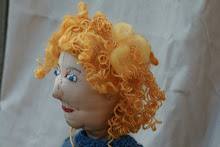The challenge for my sewing, is that these pouches need to be well padded. I made the first one with several thicknesses of flannelet and a plain cotton outer layer. I wasn't sure that it was thick enough. So, I added a layer of quilt wadding to my next attempt. That made for a softer pouch, but it was hard on my sewing machine. I broke two needles on that pouch, so I'll have to try another way.
But, it did remind me to write about sewing machine needles. Here's what a machine needle looks like:

- * nice sharp tip
- * the eye of the needle is just above the tip
- * long straight shaft
- * the top end is shaped--one side is curved and the other is flat.

- loosen off the screw holding the needle in place. That's it on the right hand side.
- remove the old needle--dispose of it thoughtfully. Remember, it's sharp!
- slide the new needle in place--in my machine, the flat part goes towards the back. Because of the shaping, you can only put the needle in one way.
- tighten up the screw again firmly.
Some points to remember--sorry I didn't intend the pun, but I'll leave it there now:)
- * sewing machine needles are a consumable--they need to be changed fairly often. If your machine isn't stitching nicely, try a new needle, it's often the solution.
- * there are different needles for different tasks: finer ones, stronger ones, special tips for different fabrics, even double needles for making two rows of stitching at once. Match the needle to the task.
- * Be nice to your needle. Don't sew over pins. Don't tug at the fabric while the needle is down. And don't expect the needle to manage too many layers of fabric--note to self there!

No comments:
Post a Comment